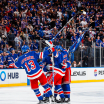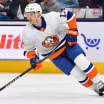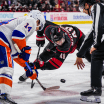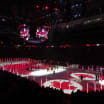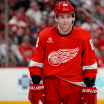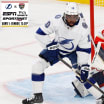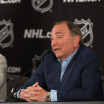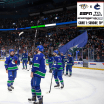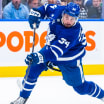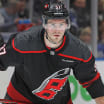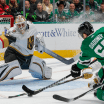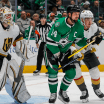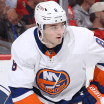NHL.com looks at how each team shapes up entering the stretch run in the race for the Stanley Cup Playoffs.
The NHL All-Star break has come and gone, and the 10-week sprint to the Stanley Cup Playoffs begins Tuesday.
Few teams have pulled far enough away from the pack to be looking ahead to the postseason or dropped far enough below it that they're out of contention. Eighteen of the 30 teams are within 10 points of one another; only 10 of those teams will make the playoffs.
NHL.com looks at the Metropolitan's second half
Washington enters second half leading race for the Presidents' Trophy
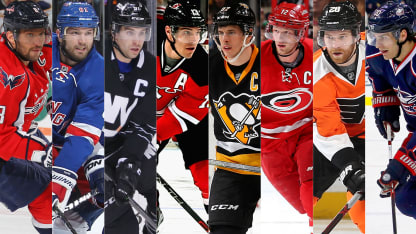
© Getty Images
Here's a look at how the eight teams in the Metropolitan Division shape up entering the race for the postseason:
WASHINGTON CAPITALS (35-8-4, 74 points, 1st in division, 1st in Eastern Conference)
Remaining games:35 (18 home, 17 away)
Special teams: Power play: 26.8 percent (1st); penalty kill: 84.7 percent (4th)
What's gone right:Almost everything. Goaltender Braden Holtby (30-5-3, 2.07 goals-against average, .929 save percentage) is the front-runner for the Vezina Trophy. The offense is deep and balanced, with Alex Ovechkin (28) leading a core of seven players who've scored at least 13 goals apiece. Though he's missed time with injuries, John Carlson's emerging as an elite defenseman, and the return of Dmitry Orlov has given coach Barry Trotz more options on the blue line. The power play has been lethal, and the penalty-killing has been almost as good.
What's gone wrong: Not much, though the Capitals' possession numbers -- they're 14th in the League in shot attempts percentage (SAT%) -- aren't what you might expect from the team with the inside track on the Presidents' Trophy. Injuries to Carlson and Brooks Orpik have forced Trotz to do some mixing and matching on defense.
Needs: Few. Washington lost fourth-line center Jay Beagle with a broken hand on Dec. 30 but signed free agent Mike Richards on Jan. 7. Richards will serve as Beagle's replacement. The Capitals don't need much else, though general manager Brian MacLellan may do some tinkering to add depth.
Trophy hopefuls: Ovechkin (Richard), Holtby (Hart, Vezina)
Schedule: Washington has its three-game trip through California in early March after a stretch in which it plays six of seven at home. The Capitals have four back-to-backs remaining; the last one is a road set against the Colorado Avalanche and Arizona Coyotes on the first two nights of April.
Outlook: The Capitals put the rest of the division in the rearview mirror before the break. They have the inside track to the Presidents' Trophy and home-ice advantage for as far as they go in the playoffs. Washington looks like the best team in the East.
NEW YORK RANGERS (27-17-5, 59 points, 2nd in division, 3rd in Eastern Conference)
Remaining games: 33 (16 home, 17 away)
Special teams: Power play: 17.5 percent (20th); penalty kill: 79.5 percent (23rd)
What's gone right: Goaltender Henrik Lundqvist fueled the Rangers' hot start, and despite a slump from Thanksgiving through the end of December, he's on pace for a typical Lundqvist season (65+ games, 35+ wins, .920+ save percentage). Center Derick Brassard (17 goals, 36 points) has built on his performance last season, and forward J.T. Miller (13 goals) was New York's hottest scorer entering the break. Ryan McDonagh leads a solid defense that has gotten a physical boost from rookie Dylan McIlrath.
What's gone wrong: Rick Nash (12 goals) is nowhere close to his 42-goal pace of last season. Young forwards Chris Kreider (9-14-23) and Kevin Hayes (7-15-22) haven't shown the consistency and scoring touch that was expected of them. The special teams have struggled; the power play went 2-for-31 in January, and the penalty kill is in the bottom third of the League. New York is 9-12-3 on the road after going 28-11-2 away from Madison Square Garden in 2014-15.
Needs: The Rangers need more scoring, especially from their top two lines, and might have to move a defenseman like impending unrestricted free agent Keith Yandle to get it.
Trophy hopefuls: None
Schedule:New York has no homestand or road trip longer than three games. The Rangers play four of five on the road in late February-early March, a stretch that includes games at the Dallas Stars, St. Louis Blues, Pittsburgh Penguins and Capitals. They'll play three games in four days in California in mid-March, and they finish with four of their final five games at the Garden.
Outlook: To make the playoffs, the Rangers will need Lundqvist to be at the top of his game, as he was before Thanksgiving, and for Nash to find his scoring touch. Unlike past seasons, they don't have a lot of wiggle room. The Rangers need to improve their special teams, and young forwards like Hayes and Kreider have to produce more.
NEW YORK ISLANDERS (25-16-6, 56 points, 3rd in division, 7th in Eastern Conference)
Remaining games:35 (15 home, 20 away)
Special teams: Power play: 17.5 percent (19th); penalty kill: 87.2 percent (2nd)
What's gone right: The play of starting goalie Jaroslav Halak and backup Thomas Greiss is the biggest reason the Islanders are competing for a playoff spot. Greiss (13-6-2, 2.32 GAA, .927 save percentage) was general manager Garth Snow's best offseason signing. Casey Cizikas between Matt Martin and Cal Clutterbuck has provided more offense than most fourth lines, as well as the expected physicality. The penalty kill, a liability last season, has been almost flawless since Thanksgiving (92.8 percent).
What's gone wrong:The offense, which carried the Islanders for most of last season, hasn't dominated possession the way it did in 2014-15 (50.29 SAT%, down from 52.79). Captain John Tavares (16 goals, 34 points) has struggled while playing with a variety of wings, and young forwards Anders Lee (six goals after he had 25 in '14-15) and Ryan Strome (17 points after getting 50 last season) have not produced as expected. The power play has struggled after a good start. The defense hasn't contributed offensively the way it did last season, and injuries to Johnny Boychuk and Travis Hamonic, two of the top three defensemen, haven't helped.
Needs: Hamonic (lower body) returned for the final two games before the break, and Boychuk (upper body) should be back when play resumes. But Snow needs to find a top-level wing to play with Tavares unless players like Lee and Strome turn their game up a few notches. He also has to decide whether to keep impending UFA forwards Kyle Okposo and Frans Nielsen, or trade them for future help.
Trophy hopefuls: None
Schedule:The Islanders play 35 games in the final 68 days of the season, most of them on the road. They have seven in a row away from Barclays Center from Feb. 19-March 6, host the Pittsburgh Penguins on March 8, then play five of the next six on the road. They do play five of their final seven games at home.
Outlook:New York has been inconsistent in its first season in Brooklyn, and the spark the Islanders showed for most of last season has rarely been evident. The Islanders' possession numbers are down, as are their scoring totals. Though they've been in the top three in the division for most of the season, the Islanders will have a tough time staying there unless a number of players step up their play.
PITTSBURGH PENGUINS (24-17-7, 55 points, 4th in division, 8th in Eastern Conference)
Remaining games:34 (16 home, 18 away)
Special teams: Power play: 19.9 percent (10th); penalty kill: 83.8 percent (7th)
What's gone right: Goaltender Marc-Andre Fleury (19-11-5, 2.28 GAA, .925 save percentage) has kept the Penguins in every game he's played. Evgeni Malkin (23 goals, 47 points) has been a consistent force offensively despite a mix of linemates and the early struggles of Sidney Crosby, who has regained his scoring touch in the past few weeks. When healthy, Kris Letang (33 points in 38 games) is an elite offensive defenseman, and the Penguins aren't the same team without him.
What's gone wrong: Crosby's slow start mirrored that of the Penguins; his revival (15 goals in the past 29 games) has triggered their improved play under new coach Mike Sullivan. Phil Kessel has 15 goals, but that's nowhere near what was expected when the Penguins acquired him from the Toronto Maple Leafs last summer. Aside from Letang and Olli Maatta, the defense has struggled for most of the season.
Needs: General manager Jim Rutherford has already added Trevor Daley to the defense and speedy forward Carl Hagelin up front, but the Penguins could use more help on the blue line and might look for a rental defenseman.
Trophy hopefuls: None
Schedule:There are no long road trips or homestands remaining for the Penguins, but there are a lot of games within the division, including 15 of their final 20. The Penguins finish with three in a row and four of their final five games on the road.
Outlook: The Penguins have been climbing the division standings after their slow start cost coach Mike Johnston his job. With Malkin and Crosby producing, and Fleury enjoying another solid season, the Penguins have the elite players to catch everyone but the Capitals, especially if Kessel finds his scoring touch.
NEW JERSEY DEVILS (25-20-5, 55 points, 5th in division, 9th in Eastern Conference)
Remaining games: 32 (17 home, 15 away)
Special teams: Power play: 18.5 percent (13th); penalty kill: 80.9 percent (14th)
What's gone right: Cory Schneider (22-15-5, 2.03 GAA, .929 save percentage) has blossomed into one of the NHL's elite goaltenders. His skill is matched by his durability; he's on pace to play 68 games. Forward Kyle Palmieri's 20 goals are more than he's ever scored in a full season, Michael Cammalleri (14 goals, 38 points in 42 games) has produced when he's been healthy, Lee Stempniak (14 goals, 36 points) was a great bargain-basement signing, and Adam Henrique (16 goals, 31 points) is on pace for NHL career highs in goals and points. John Hynes, in his NHL coaching debut, has done a superb job.
What's gone wrong: Aside from their top four forwards, the Devils don't score very much (2.24 goals per game, 29th in the NHL) and average a League-low 24.2 shots on goal per game. Their SAT% (46.82) is 28th; their faceoff percentage (46.7) is 29th. The bottom two lines have struggled offensively except for Bobby Farnham (seven goals in 26 games). The defense generates very little offense (16 goals). Schneider, for all his brilliance, is 2-4 in shootouts with a .609 save percentage.
Needs: For the Devils to make the playoffs for the first time since 2012, they'll have to find a way to score more. First-year general manager Ray Shero has some salary-cap space to work with; whether he'll be able to use it to find more offense is another question.
Trophy hopefuls: Cory Schneider (Vezina)
Schedule: New Jersey's toughest stretch comes in early March, when it plays five of six games on the road against Western Conference teams, including three games in California. The Devils finish with three consecutive home games, two against teams not likely to make the playoffs.
Outlook:New Jersey has been one of the biggest surprises of the season. Hynes has gotten just about every drop of production available from the talent he has, and Schneider has been brilliant. The question is whether the Devils can figure out a way to score more goals. If they can't, this will be four consecutive seasons without a playoff berth, the longest drought since they missed in their first five seasons after moving to New Jersey in 1982.

© Graig Abel/Getty Images
CAROLINA HURRICANES (23-20-8, 54 points, 6th in division, 10th in Eastern Conference)
Remaining games:31 (15 home, 16 away)
Special teams: Power play: 16.7 percent (25th); penalty kill: 82.5 percent (10th)
What's gone right: No team has allowed fewer shots on goal per game than the Hurricanes (26.5); they outshoot their opponents by an average of 3.6 shots per game. One reason for that is Carolina is also No. 1 on faceoffs (53.9 percent). Justin Faulk has 14 goals, 12 of them on the power play, and leads one of the NHL's best groups of young defensemen. Center Victor Rask has 12 goals, one more than he scored all last season as a rookie.
What's gone wrong: Though they don't face a lot of shots, goaltenders Cam Ward (.905 save percentage) and Eddie Lack (.904) have not stopped enough of them; Carolina's .901 save percentage is 28th in the League. Longtime No. 1 center Eric Staal (nine goals, 30 points) is on pace for his worst offensive season since 2003-04. Faulk has 12 power-play goals; the rest of the team has 14. The Hurricanes have lost seven times in overtime (and their lone shootout), meaning they've left points on the table.
Needs:The goaltending has to get better, though it's hard to see general manager Ron Francis being able to bring in a replacement for Ward, who can become an unrestricted free agent this summer. Francis has plenty of cap space and will try to find more offense; he has some prospects he can use if he decides to go shopping. He could also go the other way and see if there are any takers for Staal.
Trophy hopefuls: Faulk (Norris)
Schedule: Carolina returns from the break with three games in Canada, then plays eight of its remaining 10 games in February at PNC Arena. That's followed by seven of eight on the road to begin March, though there are no back-to-backs in that stretch.
Outlook:Second-year coach Bill Peters has the Hurricanes playing disciplined, structured hockey, helping to compensate for a lack of offensive punch. Carolina does a great job limiting its opponents' chances but will fall out of the playoff race unless the goaltending improves.
PHILADELPHIA FLYERS (21-18-8, 50 points, 7th in division, 13th in Eastern Conference)
Remaining games: 35 (18 home, 17 away)
Special teams: Power play: 17.4 percent (22nd); penalty kill: 78.0 percent (26th)
What's gone right: Michal Neuvirth (11-6-2, 2.14 GAA, .933 save percentage), signed as a free agent last summer to be the backup, has outplayed starter Steve Mason and is getting an increasing amount of playing time. Rookie defenseman Shayne Gostisbehere (eight goals, 22 points in 29 games) has scored three overtime goals and breathed life into the Flyers since being recalled from Lehigh Valley of the American Hockey League in mid-November. Center Claude Giroux has 10 points in his past nine games after an up-and-down start. New coach Dave Hakstol, in his first season in the NHL after coming from the University of North Dakota, has been up to the job.
What's gone wrong:Jakub Voracek, who had 22 goals and 81 points last season, has eight goals and 36 points through 47 games, though he had three goals and five points in Philadelphia's final three games before the break. He's one of several Flyers who've struggled to put the puck in the net; Philadelphia's 107 goals are 29th in the NHL. The power play has struggled all season, and only three teams have allowed more than the 35 man-advantage goals surrendered by the Flyers.
Needs: Offense.Giroux (14), Wayne Simmonds (14) and Brayden Schenn (12) are the only players to reach double figures in goals. The Flyers have several good prospects on defense; general manager Ron Hextall will have to decide whether he wants to trade one or more of them to bring in some scorers.
Trophy hopefuls:Gostisbehere (Calder)
Schedule:Philadelphia has 15 games in 29 days during February, including a five-game trip against Eastern Conference teams. The Flyers play six in a row at home bridging February and March, but they have a four-game, six-day trip later in the month before finishing with five of their final seven games at Wells Fargo Center.
Outlook: The Flyers are just close enough to the playoffs to have hope of qualifying, but they'll have to climb over a lot of teams to get there. As presently constituted, the Flyers don't have enough scoring; Hextall will have to decide if he wants to be a buyer or a seller at the 2016 NHL Trade Deadline on Feb. 29.
COLUMBUS BLUE JACKETS (19-27-5, 43 points, 8th in division, 16th in Eastern Conference)
Remaining games: 31 (17 home, 14 away)
Special teams: Power play: 17.9 percent (15th); penalty kill: 81.0 percent (13th)
What's gone right: Forward Boone Jenner has a career-best 17 goals, offseason acquisition Brandon Saad (19) is on pace for his first 30-goal season in the NHL, and Scott Hartnell (17) should come close to last season's 28-goal output. Defenseman Seth Jones has looked good since being acquired from the Nashville Predators earlier this month for Ryan Johansen. Rookie goaltenders Joonas Korpisalo and Anton Forsberg have shown promise after being called up from the minors because of injuries.
What's gone wrong:The Blue Jackets have never recovered from the 0-7-0 start that led to the firing of coach Todd Richards and the hiring of John Tortorella. Injuries have limited starting goaltender Sergei Bobrovsky to 27 games, and backup Curtis McElhinney was struggling (2-6-2, 3.33 GAA, .888 save percentage) even before he was injured. The Blue Jackets are last in the NHL with 161 goals-against. Forward Nick Foligno, coming off a career season (31-42-73), has six goals and 25 points in 42 games.
Needs: Tortorella has to find a way to bolster the NHL's leakiest defense; having a healthy Bobrovsky would be a major boost, but he's been injured multiple times this season and there's no timetable for his return. General manager Jarmo Kekalainen likely isn't finished shopping for help on the blue line.
Trophy hopefuls: None
Schedule: The Blue Jackets play their first three games after the break in Western Canada before returning for a five-game homestand. They have another five-game homestand in March, part of a stretch in which they play seven of eight at Nationwide Arena.
Outlook: The Blue Jackets figure to spend the next month evaluating players and determining who to bring back next season, when they are likely to add a high draft pick. Columbus has some forwards who could be attractive to contending teams, making them a likely participant as the trade deadline nears.
